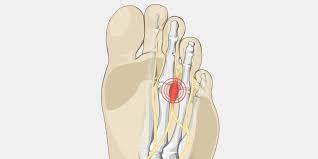Foot - Morton's neuroma
What is Morton’s neuroma?
Morton’s neuroma is a swelling or thickening in one of the small nerves in your foot, normally the nerve that runs between the third and fourth metatarsals, and provides sensibility to the third and fourth toes. When walking, your nerve may become squeezed between the two metatarsal bones, which causes pain and in the long run, inflammation. This inflammation may then cause a nodule to form, which, as it is larger than the nerve, is even more likely to be squeezed between the bones, aggravating the problem.

What causes it?
A neuroma forms as a result of a chronic irritation to the nerve. It occurs most often in patients with a high arch (a so-called ‘pes cavus’) or a tight Achilles tendon, which can cause the toes to slope slightly upwards out of correct alignment. The problem is aggravated by footwear: pointed shoes squeeze the metatarsals together, constricting the interdigital nerves, and high heels cause your bodyweight to be concentrated on the ball of your foot, which increases the pressure upwards against the nerve. This might explain why Morton’s neuroma is five times more common in female than in male patients.
How does it feel?
You will have pain in the ball of your foot when you put weight on it, which may extend into the third and fourth toes, and fizzing or numbness in the toes. Some patients describe the pain as being like having a stone in their shoe under the ball of the foot. Usually taking off your shoe and massaging your foot can bring immediate relief. The symptoms may be intermittent, with weeks or months passing between one painful episode and the next.
Diagnosis
A physical examination should be enough to diagnose a neuroma, although your doctor may ask for X-rays and/or an ecography to rule out a bone fracture. If these reveal any anomalies your doctor may ask you to undergo an MRI (magnetic resonance imaging) scan.
Treatment – conservative
Your doctor will recommend that you wear wider-fitting, flat shoes with a soft sole, and he may prescribe an insole to change your posture thus taking pressure off the neuroma. He may also prescribe cortisone injections.
Treatment – surgical
If the pain continues after conservative treatment, your surgeon will perform a Neuroma Resection, making a 3-4cm incision on the top of your foot at the base of the toes affected by the neuroma. He will then remove the neuroma, and close the incision. You may have some numbness in your toes after the operation, but this will be only temporary.
Rehabilitation after surgery
You will need to wear an open shoe for 2 weeks after the operation while the wound heals, and you may be more comfortable walking with crutches for the first couple of days.
When will I be back to normal?
You can return to office work and driving the day after the operation, although manual workers should stay off work for 12-14 days whilst the wound heals. Sporting activity can be resumed once the wound is fully healed.